Norton Commando
The Norton Commando is a British Norton-Villiers motorcycle with an OHV pre-unit parallel-twin engine, produced by the Norton Motorcycle company from 1967 until 1977. Initially having a nominal 750 cc displacement, actually 745 cc (45.5 cu in), in 1973 it became an 850 cc, actually 828 cc (50.5 cu in). It had a hemi-type head, similar to all OHV Norton engines since the early 1920s.
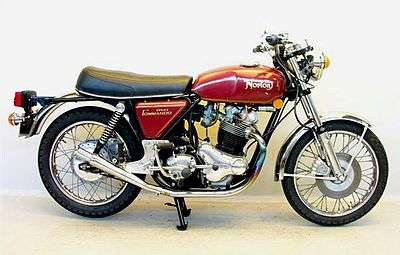 1973 Commando 850 | |
| Manufacturer | Norton-Villiers |
|---|---|
| Also called | SS, Hi-Rider, 850 Roadster, 850 Interstate |
| Engine | 745 and 828 cc (45.5 and 50.5 cu in) air-cooled OHV parallel-twin |
| Top speed | 115 mph (185 km/h) (750)[1] |
| Power | 58 bhp (43 kW) @ 6,800 rpm (750)[1] |
| Transmission | 4-speed (chain) |
| Wheelbase | 56.75 in (1,441 mm) |
| Dimensions | L: 87.5 in (2,220 mm) W: 26 in (660 mm) |
| Seat height | (nominal) 33 - 34 in (838.2 - 863.6 mm) |
| Weight | 420 lb (190 kg)[1] (dry) |
| Fuel capacity | 10 l (2.2 imp gal; 2.6 US gal) |
During its ten years of production, the Commando was popular all over the world. In the United Kingdom it won the Motor Cycle News "Machine of the Year" award for five successive years from 1968-1972.[2] Given that its engine was an old pre-unit design, even Norton's chairman, Dennis Poore, expressed surprise at the Commando's remarkable success.[3]
Background
The origins of the Norton Commando can be traced back to the late 1940s when the 497 cc (30.3 cu in) Norton Model 7 Twin was designed by Bert Hopwood. The twin-cylinder design evolved into 600 cc, then the 650 cc Manxman and Dominator until superseded by 750 cc Atlas before being launched as the 750 cc Commando in 1967.[4] As well as having a radical new frame, the Commando's engine was tilted forward. The previous featherbed framed models like the Atlas had vertically mounted engines. This forward leaning of the engine was relatively easy as the engine was "pre-unit", that is, the gearbox was not integral with the crankcase, and the change gave three benefits: (i) the centre of gravity was moved further forward; (ii) this allowed more space behind the carburettors for the airbox; and (iii) it gave an attractive raked appearance to the motorcycle.
Isolastic system
The revolutionary part of the Commando, compared to earlier Norton models, was the award-winning frame developed by former Rolls-Royce engineer Dr. Stefan Bauer.[5] He believed the classic Norton Featherbed frame design went against all engineering principles, so Bauer designed his frame around a single 2.25 in (57 mm) top tube. Bauer tried to free the Commando from classic twin vibration problems, which had severely increased as the volume of the basic engine design expanded from the 500 cc of Edward Turner's 1938 Triumph Speed Twin. He, with Norton-Villiers Chief Engineer Bernard Hooper and assistant Bob Trigg, decided that the engine, gearbox and swing-arm assembly were to be bolted together and isolated from the frame by special rubber mountings.[6]
This eliminated the extreme vibration problems that were apparent in other models in the range, as it effectively separated the rider from the engine. Named the Isolastic anti-vibration system, the system's patent document listed Hooper as the lead inventor.[7] Although the Isolastic system did reduce vibration, maintaining the required free play in the engine mountings at the correct level was crucial to its success. Too little play brought the vibration back; too much, and the result was "very poor" handling.
Models
Mk1 750 cc
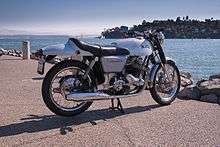
The Norton Commando was introduced in 1967 at the Earls Court Show. The first production machines completed in April 1968 had frame failure problems, which were resolved with the introduction of an improved frame in January 1969.[8]
There were numerous other design problems which were gradually addressed over the years, although some persisted to the end.[9] The early clutches could not handle the engine torque, and two small internal pins would shear off, leading to severe slippage (later resolved). The side-stand tended to break off, particularly if the owner insisted on starting the machine on the side-stand, leaving a hole in the frame beneath the engine, while the center-stand was too short to provide good support for the motorcycle, dragged on the pavement, and tended to break in half (both later improved). The engine rubber mounting system, which isolated the rider from vibration very well, left the engine to its own devices, and it shook like a commercial paint can shaker at idle.
Because the rubber-mounted engine was not restrained by the frame, it shook a great deal and parts that had worked well on previous Nortons were damaged. The rocker arm oil supply line had always been made of copper tubing, but on the Commando it would fracture from vibration. The line was later changed to nylon. The head steady would also fatigue and fracture from vibration (later improved). The Amal carbs had float needle leakage from vibration, which led to flooding and fires, exacerbated by having the ignition points located under the right hand carb (relocated to the right side of the engine after the first year). The carburettors themselves also wore out prematurely from vibration (persistent problem).
The main bearings were of two types at first, ball and roller. In 1972 both bearings became roller-type, and the crankcase was stiffened. These main roller bearings in the now stiffer case would gall at high revs, leading to main bearing failure. This was resolved after the Combat model debacle, firstly using an R&M/RHP 6/MRJA30 special bearing designated "Superblend"[10]. This was superseded by an extra high capacity FAG NJ306E standard bearing early in 1973.[10][11] Images of the bearings are available on Wikimedia Commons[12]. The threaded aluminum knobs holding the seat would strip, leaving the seat loose (never resolved). The chain guard mount would fracture (later improved).
The exhaust pipe manifold nuts were problematic to the end, loosening from vibration no matter how tightly they were fastened, leading to a ruined cylinder head and constant rattling of the header pipes. The brake light switches were unreliable, leading at times to no brake light indicator (front was improved with disc brake). The steering head bearings were ball-type, and took a permanent set under the bearing pre-load, leading to weaving at speed (later switched to roller bearings). There was a rear chain oiler which covered the rear wheel in oil, and had to be pinched off by the owner.
The speedometer drive mechanism operated from the rear wheel, with a long cable to the speedometer. This drive mechanism wore out very quickly, as did any replacement, leading to no speedometer reading (never resolved). The early tachometer drive jutted from the right side of the engine, and was vulnerable to being struck and snapped off (relocated to front of engine). The primary chain tensioning bolt tended to loosen at inconvenient times. The rear chain adjusting bolts pushed, rather than pulled, the rear axle, and would bend, making them difficult to turn. Nor were there index marks to allow equal axle positioning on the right and left side of the swing arm. The ignition switch mount would break from vibration (later relocated).
The original model, called the 'Fastback' was joined by the scrambler style 'S Type' which had a high level left-side exhaust and a 2.5-gallon (11 L) petrol tank. The first Commandos had a twin-leading-shoe front drum brake.
Production of the machine was initially complex and located across different parts of England, with the engines produced in Wolverhampton, frames in Manchester, while components and final assembly was at Burrage Grove, Plumstead. In late 1968 Plumstead works was subject to a Greater London Council compulsory purchase order, and closed in July 1969. With assistance of a Government subsidy, the assembly line was moved to North Way, Andover; with the Test Department in an aircraft hangar on Thruxton Airfield. Frame manufacturing was transferred to Wolverhampton, where a second production line produced about 80 complete machines each week. Components and complete engines and gearboxes were also shipped overnight, from Wolverhampton to the Andover assembly line.
The production racer, featuring a tuned engine, front disc brake and finished in bright yellow, was known as the 'Yellow Peril'. In March to June 1970 the updated S called the 'Roadster' had the 750 cc engine, low-level exhaust, upward-angled silencers with reverse cones. September 1970 saw the introduction of the classic 'Fastback Mk2', which had alloy levers with modified stands and chain guards. The ‘Street Scrambler’ and the ‘Hi Rider’ were launched in May 1971, with the ‘Fastback Long Range’ with increased petrol tank capacity from July 1971.
The ‘Combat engine’ engine was introduced in January 1972 saw the appearance of the ‘Mk4 Fastback’, updated ‘Roadster’ and the ‘750 Interstate’. The ‘Combat’ delivered 65 brake horsepower (48 kW) at 6500 rpm[13] with a 10:1 compression ratio, but the stressed 750 cc twin proved extremely unreliable, with main bearing failures and broken pistons common.
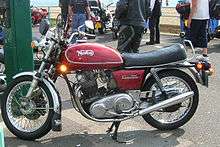
The 'Combat' engine combined with quality control problems gave the company a bad reputation, which was highly covered in the press. By the middle of 1972 BSA Triumph group were in serious financial trouble. The UK Government decided to bail the company out with a financial rescue package, providing it would agree to merge with Norton Villiers. Norton Villiers Triumph was duly formed and the new company got off to a shaky start.
The last of the 750 series, the MkV was produced from November 1972 to mid-1973 as a 1973 model and featured improved crank bearings and the standard grind camshaft. Compression was reduced to 9.4:1.
Interpol
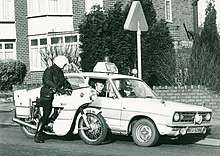
After some police forces expressed interest in the Commando, Neale Shilton was recruited from Triumph to produce a Commando to police specifications. The end result was the 'Interpol' machine, which sold well to police forces, both at home and abroad. The 750 cc machine was fitted with panniers, top box, fairing, radio mountings, police lights, and auxiliary equipment. The 'Interpol' name was retained for Norton's later Norton Interpol 2 rotary engined Police motorcycle.
1973 Mk1 850 cc
In January 1973 the ‘Mk.5 Fastback’ was launched and the ‘Long Range’ was discontinued, foreshadowing the first 850 cc machines launched in April 1973. The ‘Roadster’, ‘Hi Rider’ and the ‘Interstate’ all began to use a new 828 cc. engine, which had similar power to the 750 cc models but were less stressed.
In late 1973 redundancy notices were issued at Andover, followed by a sit-in at the works. The Conservative Government withdrew the subsidy in early 1974: it was restored after a General Election by the new Labour Government. So NVT decided to concentrate production of the Commando at Wolverhampton and Small Heath, causing unrest at Meriden which resulted in a workers’ sit in and stopping production at Small Heath. By the end of 1974 NVT had lost over £3 million.
However, the company still managed to produce new Commando models, with 1974 seeing the release of the fully faired, Roadster-based ‘JPN Replica’ (for "John Player Norton") and also the ‘Mk.2a Interstate’.
Mk3 850 cc
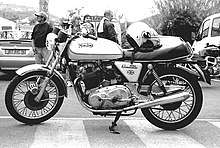

The 850 cc MK3 Commando was launched in 1975 with an improved specification – electric starter, isolastic head steady for improved vibration absorption, left side gear change and right side foot brake to comply with United States vehicle regulations, and a rear disc brake.[14]
An updated model, the 'Norton 76' was planned for 1976 but never reached production. The model featured cast wheels, twin front disc brakes and a new tank and seat.[15] A prototype '900 Commando' was also produced.[15] It used a Triumph T180 triple engine (a T160 Trident engine increased in capacity to 870 cc) in Commando cycle parts.[16] An 8 valve version of the engine was also in development.[17]
The range of models was reduced to just two machines, the ‘Mk.3 Interstate’ and the ‘Roadster’. The specification remained unchanged until October 1977 when the last machines were made, although few Roadsters were made in the end due to the higher cash sales value of the Interstate.
In 1975 the Industry Minister recalled a loan for £4 million and refused to renew the company's export credits. The company then went into receivership and redundancies were announced for all of the staff at the various sites. At Wolverhampton an action committee was formed in an effort to continue production and develop the ‘Wulf’ engine - but the works was closed anyway.
NVT was saved when the Small Heath/Meriden part of the company was subsidised by Industry Secretary Tony Benn as Industry Secretary, but this did not include Commando production. Ironically, the new company bought the gates from the demolished Tong Castle and erected them at the works entrance in Marston Road.[18]
Racing
From its 1967 beginnings the Commando took part in racing events. After successes in 1969 by dealer-entered machines like Paul Smart's second and Mick Andrew's 4th places in the Isle of Man TT Production class and a win in the Hutchinson 100 Production Class by Mick Andrew on the Gus Kuhn entered Commando and 4th by Peter Williams' Arter Bros machine, the company decided to produce a racing model, hence developed the S and "Yellow Peril" models.
In the early 1970s, with sponsorship from John Player Special cigarettes, Norton went factory racing.[19] The new race bikes were based on the Commando, and in 1973 Peter Williams won the Formula 750 Isle of Man TT on a semi-monocoque framed "JPS Norton" special which he designed as an integrated package with a Peel-type fairing incorporating handlebar blisters which helped to reduce the drag coefficient to 0.39.[20]
Shortly afterward there was a merger of Norton Villiers with BSA-Triumph (to form NVT). This event led the factory to abandon racing; and a Norton factory team did not resume racing until the Wankel-engined Nortons of the 1980s.
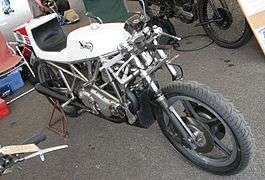 1974 "Space Triangulation" framed Commando factory racer for F750 class, successor to the 1973 Monocoque[21]
1974 "Space Triangulation" framed Commando factory racer for F750 class, successor to the 1973 Monocoque[21]- Works rider Peter Williams on the JPS-liveried 1974 factory 'Spaceframe' Norton
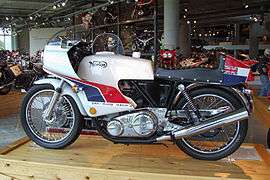 The 1974 JPN, a limited production run roadster to commemorate the TT racer's success
The 1974 JPN, a limited production run roadster to commemorate the TT racer's success
Commando revival
In light of its "last of the classic British twins" tag, and the fact that many of the trade marks were disputed and patents expired, a number of new Norton companies began to emerge. These were based on production of new parts sourced from various manufacturers, and the legal battle over the Norton name between Germany (whose Norton was based on the Rotax 650 cc engine that powers the smaller BMW motorcycles), Canada and North America. Many used the Commando name for their lead model, or included the prospect of a Commando twin at a later date.
However, the most interesting development for original Commando fans was the development of re-manufactured original motorcycles. These mainly came from Norvil in the UK[22] and two companies in the United States, Colorado Norton Works[23] and Kenny Dreer's Vintage Rebuilds based in Portland, Oregon.[24] From 1995 onwards Vintage Rebuilds began restoring vintage British and Italian motorcycles, with Dreer showing a "new" Commando based Norton VR880 Sprint Special in 1999 with newly cast and manufactured parts, but using a bored out 880 cc twin engine with some modern developments. Kenny Dreer progressed from restoring and upgrading Norton Commandos to producing whole machines. He modernised the design and in the early 2000s went into series production of the Commando 961 SS, which combined traditional Norton cafe racer styling with new technology including carbon fibre wheels to reduce weight and a chro-moly tubular steel frame.[25] Dreer was forced to suspend production in April 2006 following funding problems.[26]
The Norvil Motorcycle Company was formed to build replica models of some classic Norton models.[27] The company acquired some Norton trademarks, including the hybrid name of 'Norvil'.
New Commando 961
UK businessman Stuart Garner, owner of Norton Racing Ltd, acquired the rights to the Norton Commando brand. His company, Norton Motorcycles (UK) Ltd, established a new factory at Donington Park, Leicestershire in 2008[28] to manufacture a new Commando model, designed by Simon Skinner. There are three models in the new Commando range: a limited edition of 200 Commando 961 SEs, a Cafe Racer and a Sport model.[29] In March 2010 Norton shipped the first new Norton Commando for over 30 years; and by mid-April 2010 the Company was shipping 5-10 new machines per week.[30] The engine is a 961 cc fuel-injected air-cooled ohv 270° parallel-twin that produces 79 bhp (59 kW).[31] The short-stroke engine is oversquare, with an 88 x 79 mm bore and stroke. At the bike's front are inverted (USD) forks and twin disc brakes. The engine (rather like the BSA A7) is "semi-unit", in that the 5-speed gearbox is a separate casting, but is bolted directly to the primary chaincase. Some styling is reminiscent of the original Norton Commando, especially the engine and petrol tank. The new Norton has received favourable press reviews.[32][33] In a March 2012 interview,[34] Garner revealed that Norton was receiving support from the UK Government's Export Credit Guarantee service, which should alleviate cash-flow problems and enable a significant increase in factory output. Garner added that Norton now makes an increasing number of components "in-house", reducing reliance on outside suppliers.
See also
- Métisse Motorcycles - Mk5 Road Racer
References
- Brown 2004, pp. 106–107
- Shaw, Alan. "Norton Commando, A Short History". Archived from the original on 22 July 2018. Retrieved 7 February 2017.
- "`". Motor Cycle News. 1972.
- Bacon 1989, pp. 6–7
- Woollett 2004
- Smith, Robert (January–February 2008). "Oddball Norton Commandos". Motorcycle Classics. Retrieved 10 August 2009.
- 1974 Norton Commando Motorcycle Archived 18 March 2012 at the Wayback Machine
- Classic British Motorcycles. "Norton Commando". Classic-British-Motorcycles.com. Retrieved 29 December 2016.
- Bacon 1981, pp. 70–71, 73–74
- Heathwood, Andrew (1 March 2018). "A summary of data and information on Norton Commando main bearings" (PDF). Norton Owners Club.
- Bacon, Roy (1987). Norton Twin Restoration. London: Osprey. p. 67. ISBN 0-85045-708-4.
- Heathwood, Andrew (13 February 2018). "Norton Commando 750 Technical". Wikimedia Commons.
- Haynes 1990
- "The Powerchoice. The New Commando 850 Mk3". Bike. October 1975. p. 2. (full page colour advertisement)
- Tanshanomi, Peter (6 January 2015). "Two Wheel Tuesday: Last Gasp Norton Isolastics". Hooniverse. Archived from the original on 15 September 2018. Retrieved 14 September 2018.
- Brooke 2002, p. 125
- Hyde, Norman. "History". normanhyde.co.uk. Retrieved 15 September 2018.
- "NortonVilliers". Archived from the original on 4 August 2012. Retrieved 16 October 2011.
- Bacon 1989, pp. 50–51
- "`". Motor Cyclist Illustrated. September 1973. p. 2. (full page colour advertisement) From John Player Norton: The Norton Twins. "The unique semi-monococque construction gives the Norton the advantage of less weight, improved ground clearance and better banking angles than other, ordinary bikes. Even the blunt fairing was designed to reduce the drag coefficient to a remarkable 0.39"
- "`". Motorcyclist Illustrated. June 1974. Rear page John Player Norton colour advertisement. "A new look, a new bike, and a new season."
- "The Norvil Motorcycle Company supply spares, accessories and parts for Norton and Norvil bikes". www.norvilmotorcycle.co.uk. Retrieved 15 September 2018.
- "Colorado Norton Works | Custom Norton Motorcycles". coloradonortonworks.com. Retrieved 15 September 2018.
- "Norton Motorcycles (UK) Ltd". www.nortonmotorcycles.com. Archived from the original on 5 July 2008. Retrieved 15 September 2018.
- "Norton Commando 961 SS 'Signature Series'". Retrieved 4 November 2008.
- "Norton goes bust. Again". Retrieved 4 November 2008.
- "The Norvil Motorcycle Company supply spares, accessories and parts for Norton and Norvil bikes". Retrieved 7 February 2017.
- "History". Norton Motorcycles (UK) Ltd. Retrieved 25 April 2017.
- "Norton Motorcycles (UK) Ltd". Retrieved 7 February 2017.
- "Norton Motorcycles (UK) Ltd". Retrieved 14 April 2010.
- "Norton Motorcycles (UK) Ltd". www.nortonmotorcycles.com. Archived from the original on 24 December 2011. Retrieved 15 September 2018.
- "Norton Commando 961 SE (2009-on) Review". Motorcycle News. Retrieved 7 February 2017.
- "`". Bike Rider (77). November 2010.
- "`". Motorcycle News. 14 March 2012.
| Wikimedia Commons has media related to Norton Commando. |
Bibliography
- Bacon, Roy Hunt (1981). Norton Twins: The Postwar 500, 600, 650, 750, 850 and Lightweight Twins. Osprey. ISBN 9780850454239.CS1 maint: ref=harv (link)
- Bacon, Roy H. (1989). Norton Commando, All Models. Niton Publishing. ISBN 9780951420430.CS1 maint: ref=harv (link)
- Brooke, Lindsay (2002). Triumph : A Century of Passion and Power. MotorBooks International. ISBN 9781610592277.CS1 maint: ref=harv (link)
- Brown, Roland (2004). Ultimate History Of Fast Bikes. Parragon. ISBN 9781405437325. ASIN 1405437324.CS1 maint: ref=harv (link)
- Clarke, R. M. (2001). Norton Commando: Ultimate Portfolio. Brooklands Books Limited. ISBN 9781855205703.
- Haynes, John (1990). Norton Commando Owners Workshop Manual, No. 125: '68-'77. Haynes Manuals N. America, Incorporated. ISBN 9780856961250.CS1 maint: ref=harv (link)
- Henshaw, Peter (2017). The Norton Commando Bible: All models 1968 to 1978. Veloce Publishing. ISBN 9781787110069.
- Vale, Matthew (2011). Norton Commando: The Complete Story. Crowood Press UK. ISBN 9781847972385.
- Woollett, Mick (2004). Norton: The Complete Illustrated History. MBI Publishing Company LLC. ISBN 9780760319840.CS1 maint: ref=harv (link)